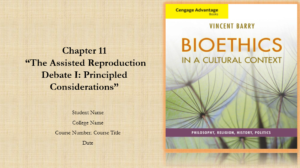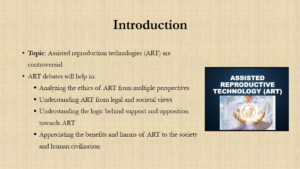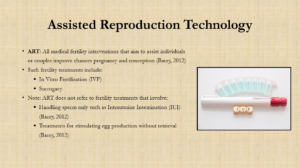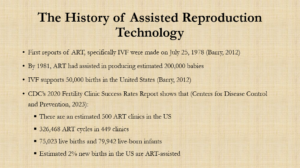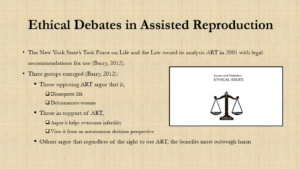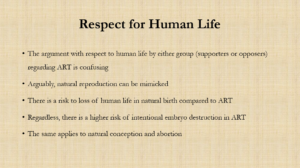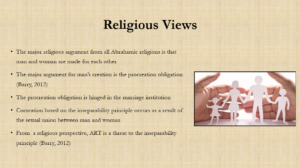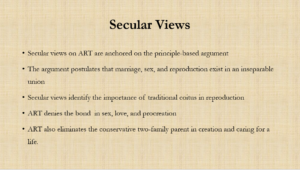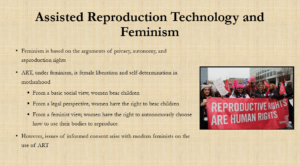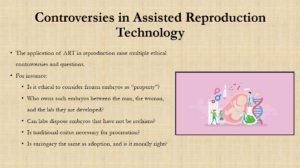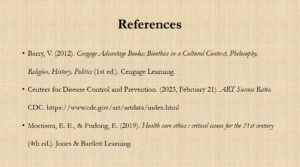Chapter 11 – The Assisted Reproduction Debate I: Principled Considerations
Hello. I have chosen to focus on Chapter 11, “The Assisted Reproduction Debate I: Principled Considerations,” of the Cengage Advantage Book titled, Bioethics in a cultural context, philosophy, religion, history, and politics by Larry Vincent. Welcome to my presentation. Our assignment writing services will allow you to attend to more important tasks as our experts handle your task.
Assisted reproduction technologies (ART), through their history of application in reproductive healthcare, are controversial. However, the ART debate is one that is majorly avoided, but it is one we need to have. Having an ART debate will open a new world that enables us to analyze the technology from multiple ethical perspectives and social and cultural views such as religious, modernism, feminism, secular, and traditional views. It will also enable us to understand the legality of ART. ART faces mixed reception with various groups and views, such as procreative liberty views supporting ART, while conservatives remain in opposition to the technology (Barry, 2012). ART-focused debates will help in understanding the logic behind the support or opposition of the technology. Most importantly, we will get to understand and appreciate the benefits and harms of ART to society and human civilization.
According to Barry (2012), ART specifically refers to fertility interventions or treatments that aim to assist individuals or couples in improving their chances of pregnancy and having a baby. Such treatment refers to In Vitro Fertilization (IVF), in which the egg and sperm are retrieved from the body of the man and woman, then fused in a lab and later implanted into the woman’s uterus, and surrogacy which is basically a contract to bear somebody else’s child. It is noteworthy that ART does not refer to fertility treatments that only involve the handling of the sperm, such as Intrauterine Insemination (IUI), and treatments that only stimulate the production of an egg without retrieval from the woman’s body (Barry, 2012).
The use of ART in improving fertility, especially IVF, spans over three decades. The media made the first reports of ART use, specifically IVF, on July 25, 1978, after a client, Mrs. Brown, had a successful IVF performed by obstetrician Dr. Patrick Steptoe (Barry, 2012). Since then, many people and couples have sought ART support to improve their fertility. As of 1981, a total of 200,000 babies had been produced using ART, and it is estimated that IVF supports 50,000 births in the United States (Barry, 2012). According to the CDC’s 2020 Fertility Clinic Success Rates Report (Centers for Disease Control and Prevention, 2023), the US today has an estimated 500 ART clinics. The report notes that there were 326,468 ART cycles in 449 clinics, from which 75,023 resulted in live births and 79,942 were live-born infants. Additionally, of all the new births in the US today, an estimated 2% of these are noted to be ART-assisted.
The New York State’s Task Force on Life and the Law issued its analysis of ART in 2001 with legal recommendations for policy to guide how ART can be used legally and ethically to support reproduction (Barry, 2012). However, various debates have risen since the beginning of the use of ART. There are groups that have emerged; those that oppose the use of ART arguing that such technologies disrespect life in its purity of birth and dehumanize women and view them as objects of giving birth only. The other debating group supports the use of ART, arguing that it is a technology that has helped individuals and couples overcome infertility and that women have the right to and should make autonomous decisions on how they bear children. Another group argues that even though people have the right to use ART, consideration must be made to balance the benefits and harms of using ART.
Those in support and opposition to ART base their arguments on various reasons. The rights argument for ART use in improving fertility is the most powerful, principle-based argument so far. The group in support of ART argues for procreative liberty, arguing that women have the right to choose whether to have children or not. Those in opposition to ART argue that the fetus has a right to life. This argument aligns with the beginning of human life from fertilization and antiabortion arguments. How ART approaches fertilization may deny the fetus the right to life. The fetal right to life has more religious and non-religious support than the procreative liberty argument.
It is hard to resolve the debate on ART. All raised arguments from the supporters and opposers of ART can be quite confusing. Both argue from the viewpoint of respecting human life, and either side can be noted to be right in their argument. Arguably, natural reproduction can be mimicked. From a supporting perspective of ART regarding respect for human life, the risk of loss of human life in natural birth is high compared to using ART. However, in opposition to ART, there is a higher risk of intentional embryo destruction in ART, but the same can be applied to natural conception and the right to abortion.
Resolving the confusion in the ART debate requires exploring the views on the use of technology from wider social views, including cultural, religious, and secular views. Based on the arguments of Morrison and Furlong (2019, p.59), technology provides many options for human reproduction, further complicating the ethical issues related to human reproduction. The morality of human reproduction is based on the wider societal view of human life and reproduction. This means that no single viewpoint can justify or deny the moral status of ART in human reproduction.
ART opposes or conflicts with religious views regarding respect for human life and reproduction. The major religious argument from all Abrahamic religions is that man and woman are made for each other, and that man’s creation is purposeful and guided by the procreation obligation (Barry, 2012). Going deeper into religious views, the procreation obligation can only be fulfilled through the marriage institution. The support for this argument is the inseparability principle. This is a doctrine that means reproduction or cocreation occurs and must only occur due to the sexual union between man and woman. Therefore, the application of ART is a threat to the inseparability principle (Barry, 2012).
The secular perspectives on ART are anchored on the principle-based argument. The principle-based argument is not basically religious but based on rationality. The secular argument towards the opposition of ART is that marriage, sex, and reproduction exist in an inseparable union. Traditional coitus remains an important aspect of reproduction, leading to the argument that ART denies the development of the bond in sex, love, and procreation. Additionally, due to the approaches of ART to reproduction, the application of such technologies in procreation is a risk to the basic marriage and family institution as it eliminates the conservative two-family parent (a man and a woman) in procreation and caring for a life.
Feminism arguments arise from the need for women’s right to autonomy and self-determination. With regard to reproductive health, feminism argues that women have the right to privacy, autonomy, and overall reproductive rights. Women have the right to choose when and how they have children. From a feminist perspective, ART presents female liberation and self-determination in motherhood. From a basic social view, women are expected to bear children, while from a legal view, women have the right to bear children. Femicentric views argue that women have the right to autonomously choose how to use their bodies to reproduce. Regardless, the major ethical argument from the feminist’s view of ART is the issue of informed consent on the use of ART to support fertility and reproduction.
As earlier noted, ART is controversial in nature. A number of controversies arise with the application of ART in reproduction regardless of whether viewed from legal, social, ethical, religious, secular, or feminist perspectives. As a result, this complicates the ethics of ART in reproduction, regardless of whether it is beneficial or harmful.
In conclusion, Chapter 11 helps the reader understand the ethics of assisted reproduction technologies from various cultural views. It also highlights the controversies associated with such technologies and answers multiple questions on life, where it begins and where it ends what can be considered as a human being, and what is the purpose of life from philosophical, religious, historical, and political perspectives. The main points I have taken from the Chapter include 1) ART is controversial whether viewed from a legal, ethical, or social perspective; 2) ART is both beneficial and harmful to society and civilization; and 3) all principled arguments, whether in support or opposition to ART are contradictory and confusing.
Barry, V. (2012). Cengage Advantage Books; Bioethics in a Cultural Context, Philosophy, Religion, History, Politics (1st ed.). Cengage Learning.
Centers for Disease Control and Prevention. (2023, February 21). ART Success Rates. CDC. https://www.cdc.gov/art/artdata/index.html
Morrison, E. E., & Furlong, E. (2019). Health care ethics : critical issues for the 21st century (4th ed.). Jones & Bartlett Learning
ORDER A PLAGIARISM-FREE PAPER HERE
We’ll write everything from scratch
Question
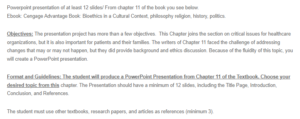
Chapter 11 – The Assisted Reproduction Debate I: Principled Considerations
Powerpoint presentation of at least 12 slides/ From chapter 11 of the book you see below.
Ebook: Cengage Advantage Book: Bioethics in a Cultural Context, philosophy religion, history, politics.
Objectives: The presentation project has more than a few objectives. This Chapter joins the section on critical issues for healthcare organizations, but it is also important for patients and their families. The writers of Chapter 11 faced the challenge of addressing changes that may or may not happen, but they did provide background and ethics discussion. Because of the fluidity of this topic, you will create a PowerPoint presentation.
Format and Guidelines: The student will produce a PowerPoint Presentation from Chapter 11 of the Textbook. Choose your desired topic from this chapter. The Presentation should have a minimum of 12 slides, including the Title Page, Introduction, Conclusion, and References.
The student must use other textbooks, research papers, and articles as references (minimum 3).

